Financial Analysis: EMA 18K Assignment on Financial Management
VerifiedAdded on 2021/10/14
|19
|4096
|31
Homework Assignment
AI Summary
This document presents a comprehensive solution to an EMA 18K financial management assignment, addressing key concepts such as net present value (NPV), foreign exchange risk, and credit risk assessment. The solution begins with calculating the NPV of cash flow gaps under different discount rates, demonstrating the impact of interest rate changes. It then delves into foreign exchange risk, specifically transaction exposure, and explores hedging strategies like forward rate agreements, future contracts, and options. Furthermore, the assignment assesses the creditworthiness of the American Red Cross, analyzing its market reputation, financial performance, and working capital to determine its ability to handle a large credit order. The document provides detailed calculations and explanations for each question, offering a thorough understanding of the financial management principles involved.
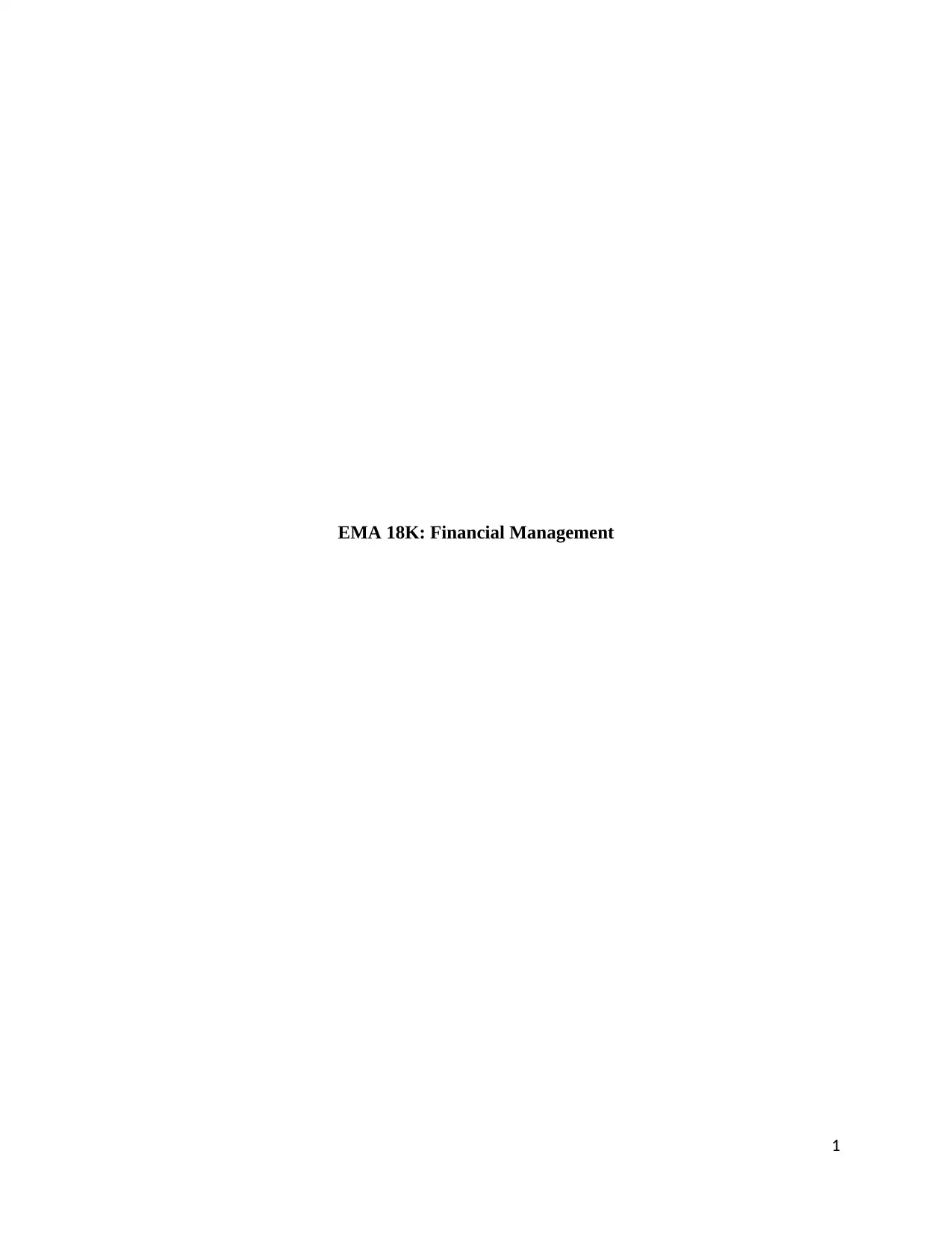
EMA 18K: Financial Management
1
1
Paraphrase This Document
Need a fresh take? Get an instant paraphrase of this document with our AI Paraphraser
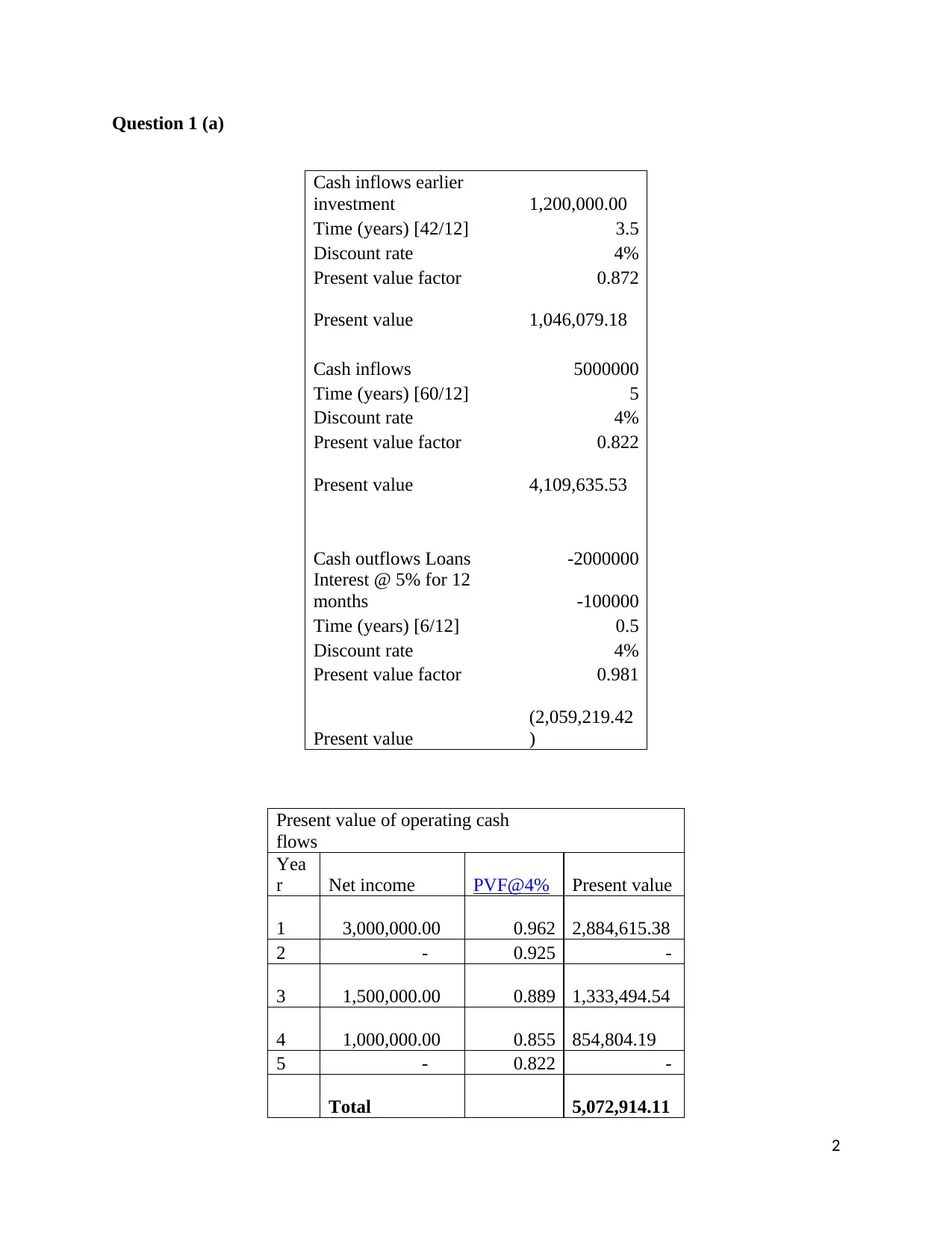
Question 1 (a)
Cash inflows earlier
investment 1,200,000.00
Time (years) [42/12] 3.5
Discount rate 4%
Present value factor 0.872
Present value 1,046,079.18
Cash inflows 5000000
Time (years) [60/12] 5
Discount rate 4%
Present value factor 0.822
Present value 4,109,635.53
Cash outflows Loans -2000000
Interest @ 5% for 12
months -100000
Time (years) [6/12] 0.5
Discount rate 4%
Present value factor 0.981
Present value
(2,059,219.42
)
Present value of operating cash
flows
Yea
r Net income PVF@4% Present value
1 3,000,000.00 0.962 2,884,615.38
2 - 0.925 -
3 1,500,000.00 0.889 1,333,494.54
4 1,000,000.00 0.855 854,804.19
5 - 0.822 -
Total 5,072,914.11
2
Cash inflows earlier
investment 1,200,000.00
Time (years) [42/12] 3.5
Discount rate 4%
Present value factor 0.872
Present value 1,046,079.18
Cash inflows 5000000
Time (years) [60/12] 5
Discount rate 4%
Present value factor 0.822
Present value 4,109,635.53
Cash outflows Loans -2000000
Interest @ 5% for 12
months -100000
Time (years) [6/12] 0.5
Discount rate 4%
Present value factor 0.981
Present value
(2,059,219.42
)
Present value of operating cash
flows
Yea
r Net income PVF@4% Present value
1 3,000,000.00 0.962 2,884,615.38
2 - 0.925 -
3 1,500,000.00 0.889 1,333,494.54
4 1,000,000.00 0.855 854,804.19
5 - 0.822 -
Total 5,072,914.11
2
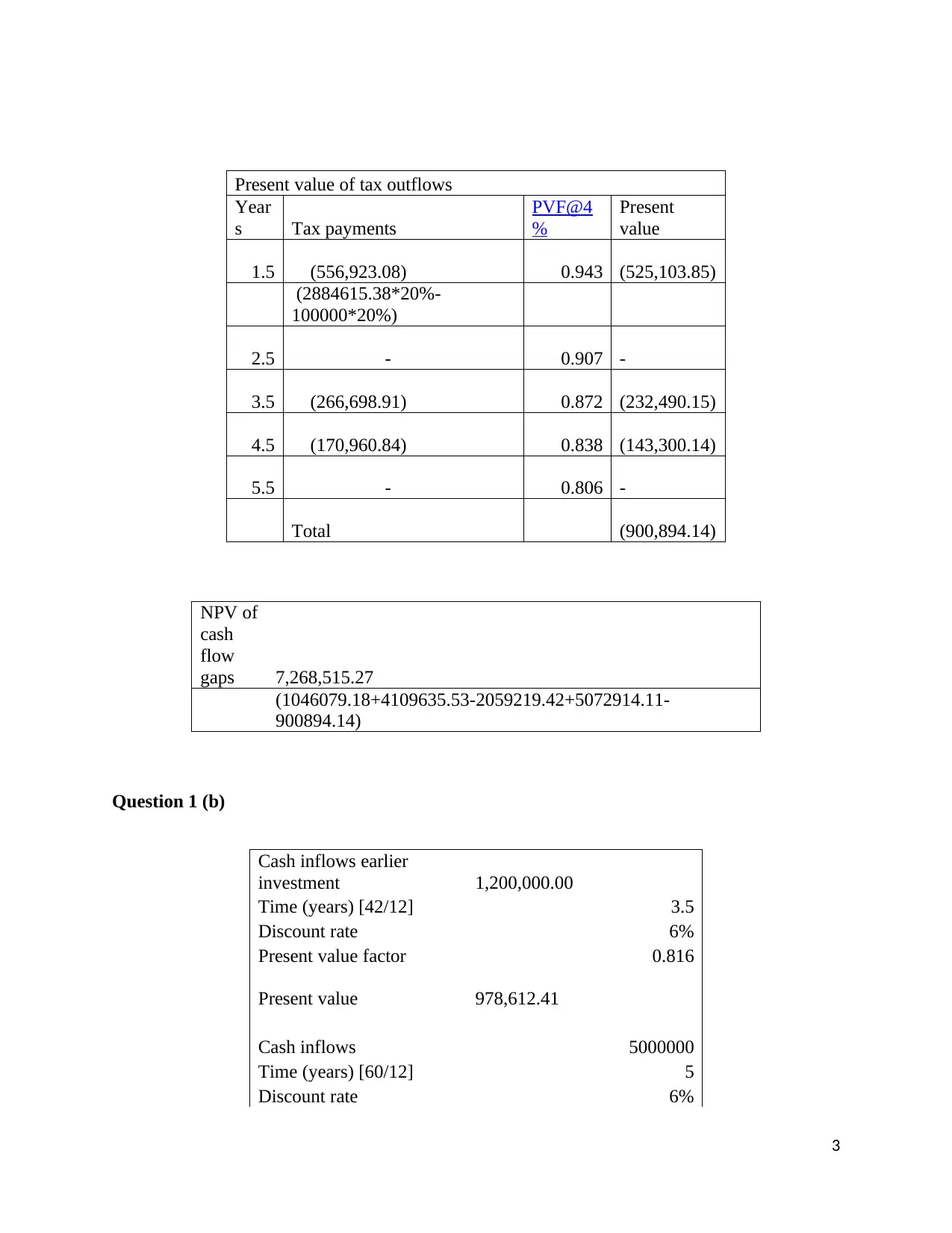
Present value of tax outflows
Year
s Tax payments
PVF@4
%
Present
value
1.5 (556,923.08) 0.943 (525,103.85)
(2884615.38*20%-
100000*20%)
2.5 - 0.907 -
3.5 (266,698.91) 0.872 (232,490.15)
4.5 (170,960.84) 0.838 (143,300.14)
5.5 - 0.806 -
Total (900,894.14)
NPV of
cash
flow
gaps 7,268,515.27
(1046079.18+4109635.53-2059219.42+5072914.11-
900894.14)
Question 1 (b)
Cash inflows earlier
investment 1,200,000.00
Time (years) [42/12] 3.5
Discount rate 6%
Present value factor 0.816
Present value 978,612.41
Cash inflows 5000000
Time (years) [60/12] 5
Discount rate 6%
3
Year
s Tax payments
PVF@4
%
Present
value
1.5 (556,923.08) 0.943 (525,103.85)
(2884615.38*20%-
100000*20%)
2.5 - 0.907 -
3.5 (266,698.91) 0.872 (232,490.15)
4.5 (170,960.84) 0.838 (143,300.14)
5.5 - 0.806 -
Total (900,894.14)
NPV of
cash
flow
gaps 7,268,515.27
(1046079.18+4109635.53-2059219.42+5072914.11-
900894.14)
Question 1 (b)
Cash inflows earlier
investment 1,200,000.00
Time (years) [42/12] 3.5
Discount rate 6%
Present value factor 0.816
Present value 978,612.41
Cash inflows 5000000
Time (years) [60/12] 5
Discount rate 6%
3
⊘ This is a preview!⊘
Do you want full access?
Subscribe today to unlock all pages.

Trusted by 1+ million students worldwide
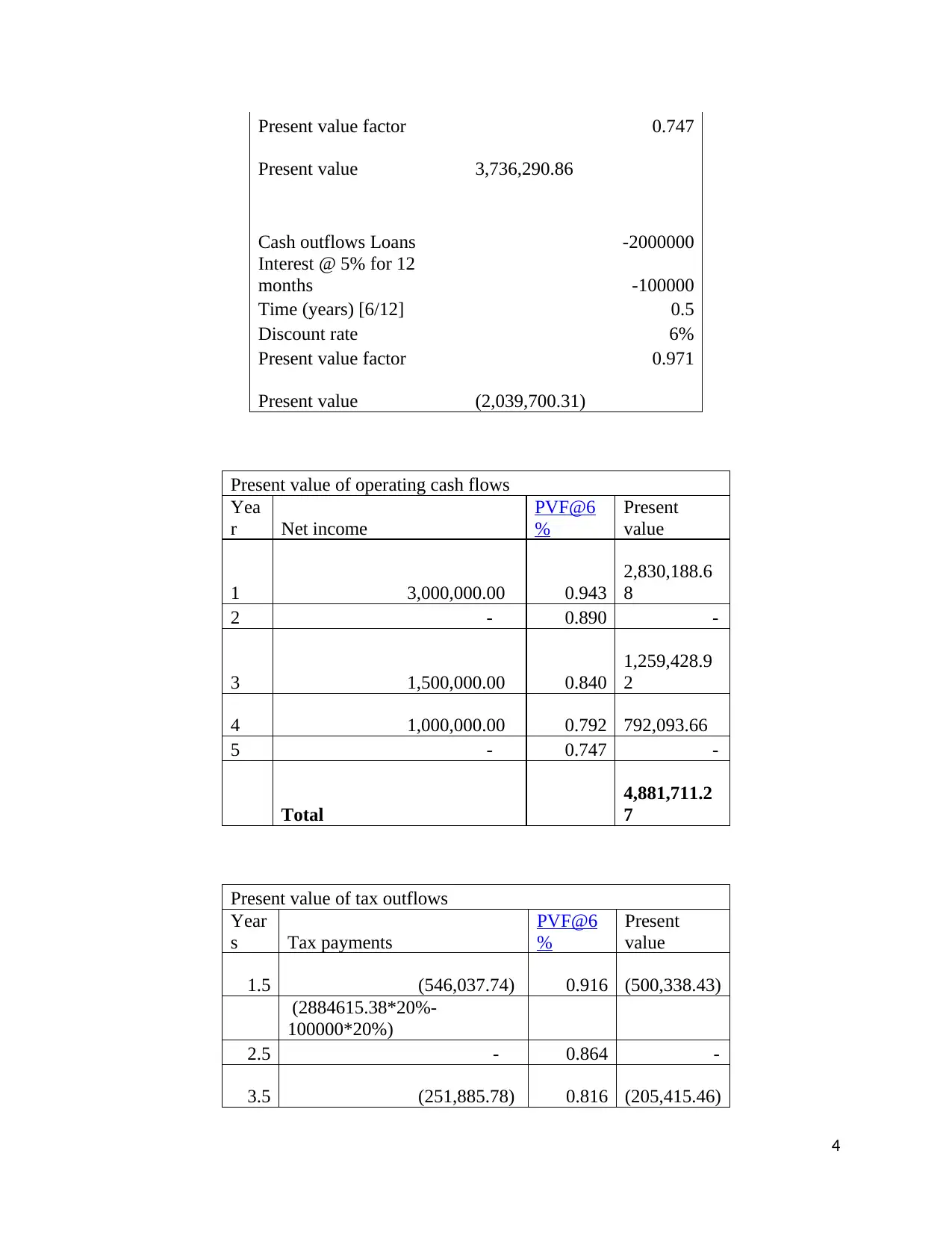
Present value factor 0.747
Present value 3,736,290.86
Cash outflows Loans -2000000
Interest @ 5% for 12
months -100000
Time (years) [6/12] 0.5
Discount rate 6%
Present value factor 0.971
Present value (2,039,700.31)
Present value of operating cash flows
Yea
r Net income
PVF@6
%
Present
value
1 3,000,000.00 0.943
2,830,188.6
8
2 - 0.890 -
3 1,500,000.00 0.840
1,259,428.9
2
4 1,000,000.00 0.792 792,093.66
5 - 0.747 -
Total
4,881,711.2
7
Present value of tax outflows
Year
s Tax payments
PVF@6
%
Present
value
1.5 (546,037.74) 0.916 (500,338.43)
(2884615.38*20%-
100000*20%)
2.5 - 0.864 -
3.5 (251,885.78) 0.816 (205,415.46)
4
Present value 3,736,290.86
Cash outflows Loans -2000000
Interest @ 5% for 12
months -100000
Time (years) [6/12] 0.5
Discount rate 6%
Present value factor 0.971
Present value (2,039,700.31)
Present value of operating cash flows
Yea
r Net income
PVF@6
%
Present
value
1 3,000,000.00 0.943
2,830,188.6
8
2 - 0.890 -
3 1,500,000.00 0.840
1,259,428.9
2
4 1,000,000.00 0.792 792,093.66
5 - 0.747 -
Total
4,881,711.2
7
Present value of tax outflows
Year
s Tax payments
PVF@6
%
Present
value
1.5 (546,037.74) 0.916 (500,338.43)
(2884615.38*20%-
100000*20%)
2.5 - 0.864 -
3.5 (251,885.78) 0.816 (205,415.46)
4
Paraphrase This Document
Need a fresh take? Get an instant paraphrase of this document with our AI Paraphraser
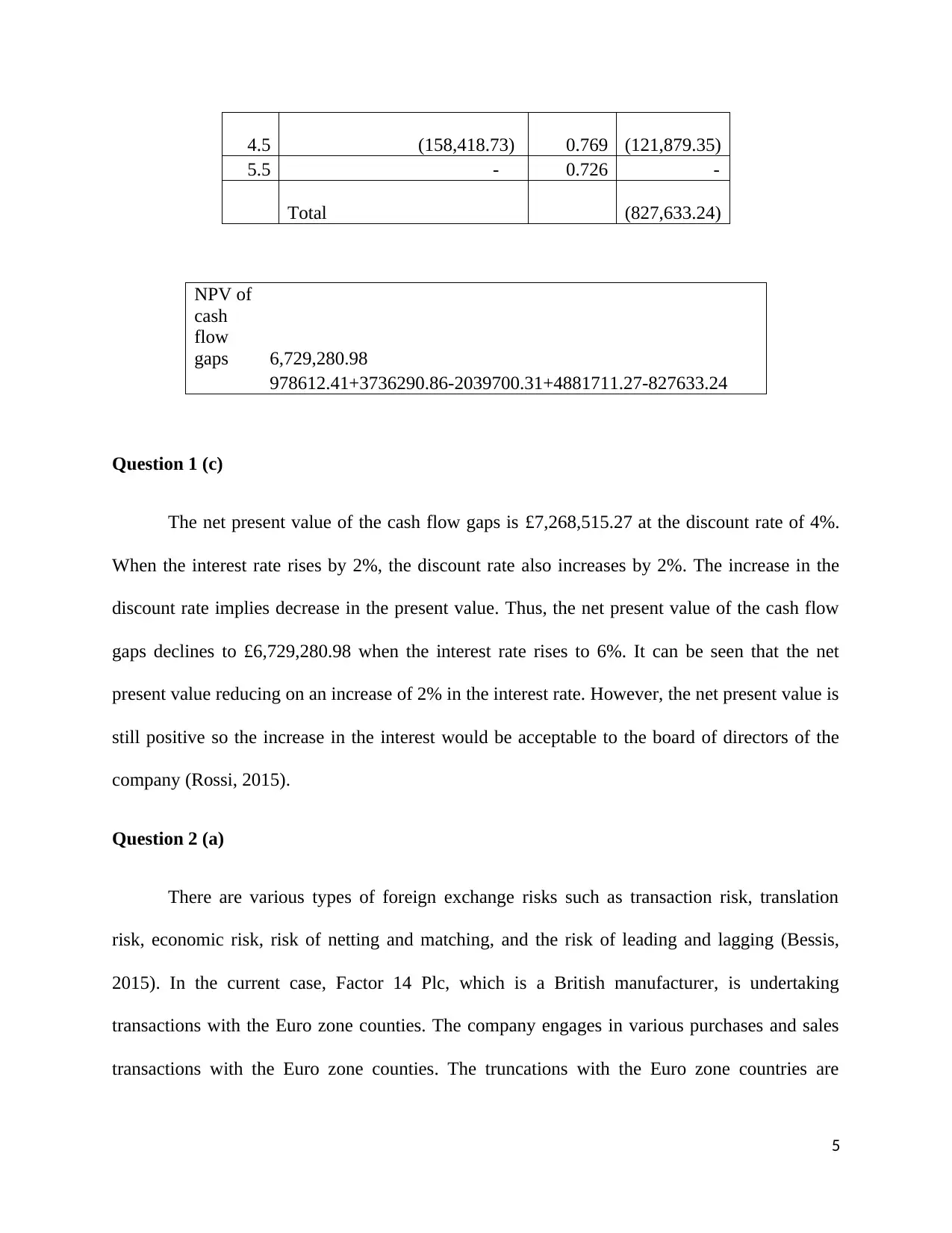
4.5 (158,418.73) 0.769 (121,879.35)
5.5 - 0.726 -
Total (827,633.24)
NPV of
cash
flow
gaps 6,729,280.98
978612.41+3736290.86-2039700.31+4881711.27-827633.24
Question 1 (c)
The net present value of the cash flow gaps is £7,268,515.27 at the discount rate of 4%.
When the interest rate rises by 2%, the discount rate also increases by 2%. The increase in the
discount rate implies decrease in the present value. Thus, the net present value of the cash flow
gaps declines to £6,729,280.98 when the interest rate rises to 6%. It can be seen that the net
present value reducing on an increase of 2% in the interest rate. However, the net present value is
still positive so the increase in the interest would be acceptable to the board of directors of the
company (Rossi, 2015).
Question 2 (a)
There are various types of foreign exchange risks such as transaction risk, translation
risk, economic risk, risk of netting and matching, and the risk of leading and lagging (Bessis,
2015). In the current case, Factor 14 Plc, which is a British manufacturer, is undertaking
transactions with the Euro zone counties. The company engages in various purchases and sales
transactions with the Euro zone counties. The truncations with the Euro zone countries are
5
5.5 - 0.726 -
Total (827,633.24)
NPV of
cash
flow
gaps 6,729,280.98
978612.41+3736290.86-2039700.31+4881711.27-827633.24
Question 1 (c)
The net present value of the cash flow gaps is £7,268,515.27 at the discount rate of 4%.
When the interest rate rises by 2%, the discount rate also increases by 2%. The increase in the
discount rate implies decrease in the present value. Thus, the net present value of the cash flow
gaps declines to £6,729,280.98 when the interest rate rises to 6%. It can be seen that the net
present value reducing on an increase of 2% in the interest rate. However, the net present value is
still positive so the increase in the interest would be acceptable to the board of directors of the
company (Rossi, 2015).
Question 2 (a)
There are various types of foreign exchange risks such as transaction risk, translation
risk, economic risk, risk of netting and matching, and the risk of leading and lagging (Bessis,
2015). In the current case, Factor 14 Plc, which is a British manufacturer, is undertaking
transactions with the Euro zone counties. The company engages in various purchases and sales
transactions with the Euro zone counties. The truncations with the Euro zone countries are
5
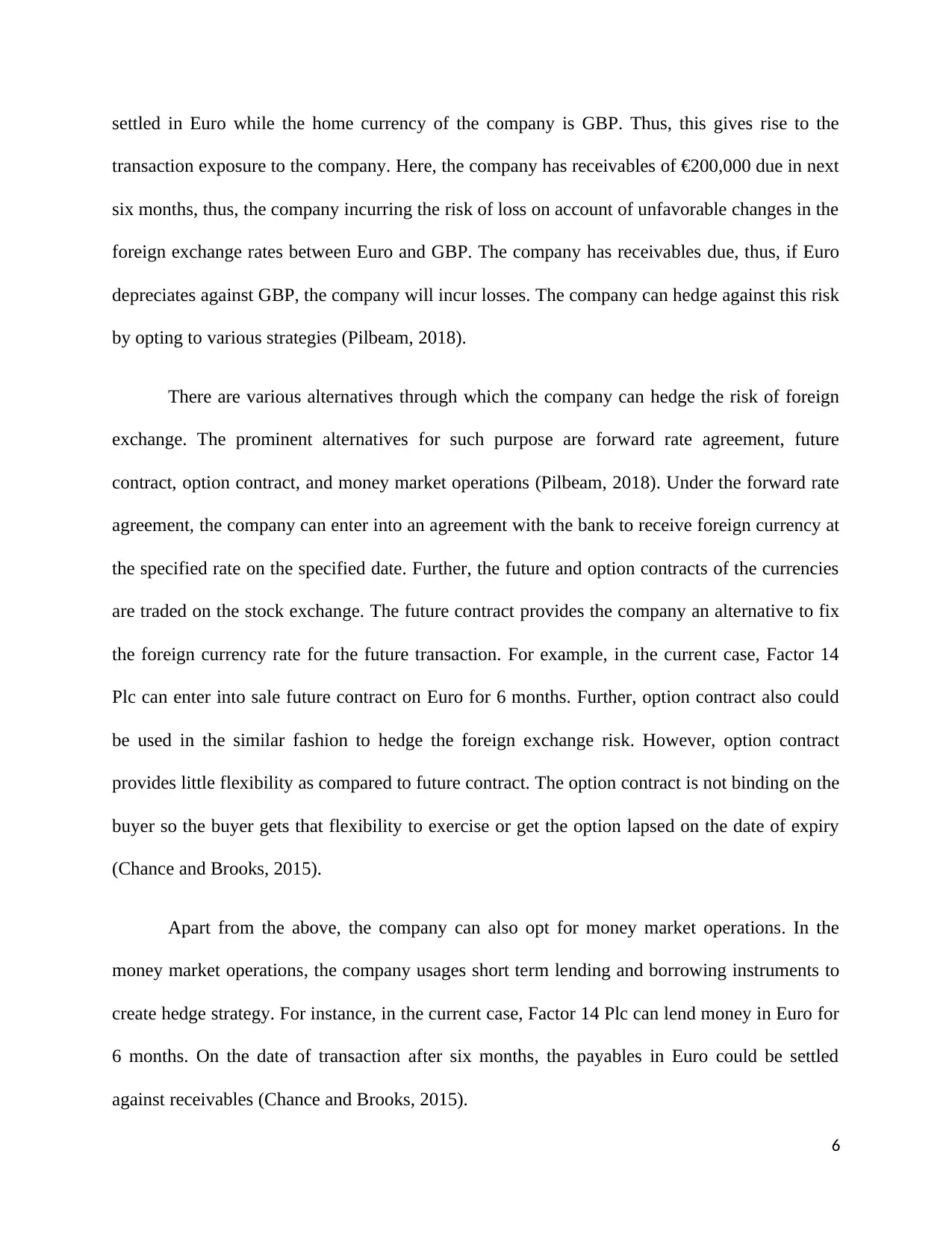
settled in Euro while the home currency of the company is GBP. Thus, this gives rise to the
transaction exposure to the company. Here, the company has receivables of €200,000 due in next
six months, thus, the company incurring the risk of loss on account of unfavorable changes in the
foreign exchange rates between Euro and GBP. The company has receivables due, thus, if Euro
depreciates against GBP, the company will incur losses. The company can hedge against this risk
by opting to various strategies (Pilbeam, 2018).
There are various alternatives through which the company can hedge the risk of foreign
exchange. The prominent alternatives for such purpose are forward rate agreement, future
contract, option contract, and money market operations (Pilbeam, 2018). Under the forward rate
agreement, the company can enter into an agreement with the bank to receive foreign currency at
the specified rate on the specified date. Further, the future and option contracts of the currencies
are traded on the stock exchange. The future contract provides the company an alternative to fix
the foreign currency rate for the future transaction. For example, in the current case, Factor 14
Plc can enter into sale future contract on Euro for 6 months. Further, option contract also could
be used in the similar fashion to hedge the foreign exchange risk. However, option contract
provides little flexibility as compared to future contract. The option contract is not binding on the
buyer so the buyer gets that flexibility to exercise or get the option lapsed on the date of expiry
(Chance and Brooks, 2015).
Apart from the above, the company can also opt for money market operations. In the
money market operations, the company usages short term lending and borrowing instruments to
create hedge strategy. For instance, in the current case, Factor 14 Plc can lend money in Euro for
6 months. On the date of transaction after six months, the payables in Euro could be settled
against receivables (Chance and Brooks, 2015).
6
transaction exposure to the company. Here, the company has receivables of €200,000 due in next
six months, thus, the company incurring the risk of loss on account of unfavorable changes in the
foreign exchange rates between Euro and GBP. The company has receivables due, thus, if Euro
depreciates against GBP, the company will incur losses. The company can hedge against this risk
by opting to various strategies (Pilbeam, 2018).
There are various alternatives through which the company can hedge the risk of foreign
exchange. The prominent alternatives for such purpose are forward rate agreement, future
contract, option contract, and money market operations (Pilbeam, 2018). Under the forward rate
agreement, the company can enter into an agreement with the bank to receive foreign currency at
the specified rate on the specified date. Further, the future and option contracts of the currencies
are traded on the stock exchange. The future contract provides the company an alternative to fix
the foreign currency rate for the future transaction. For example, in the current case, Factor 14
Plc can enter into sale future contract on Euro for 6 months. Further, option contract also could
be used in the similar fashion to hedge the foreign exchange risk. However, option contract
provides little flexibility as compared to future contract. The option contract is not binding on the
buyer so the buyer gets that flexibility to exercise or get the option lapsed on the date of expiry
(Chance and Brooks, 2015).
Apart from the above, the company can also opt for money market operations. In the
money market operations, the company usages short term lending and borrowing instruments to
create hedge strategy. For instance, in the current case, Factor 14 Plc can lend money in Euro for
6 months. On the date of transaction after six months, the payables in Euro could be settled
against receivables (Chance and Brooks, 2015).
6
⊘ This is a preview!⊘
Do you want full access?
Subscribe today to unlock all pages.

Trusted by 1+ million students worldwide
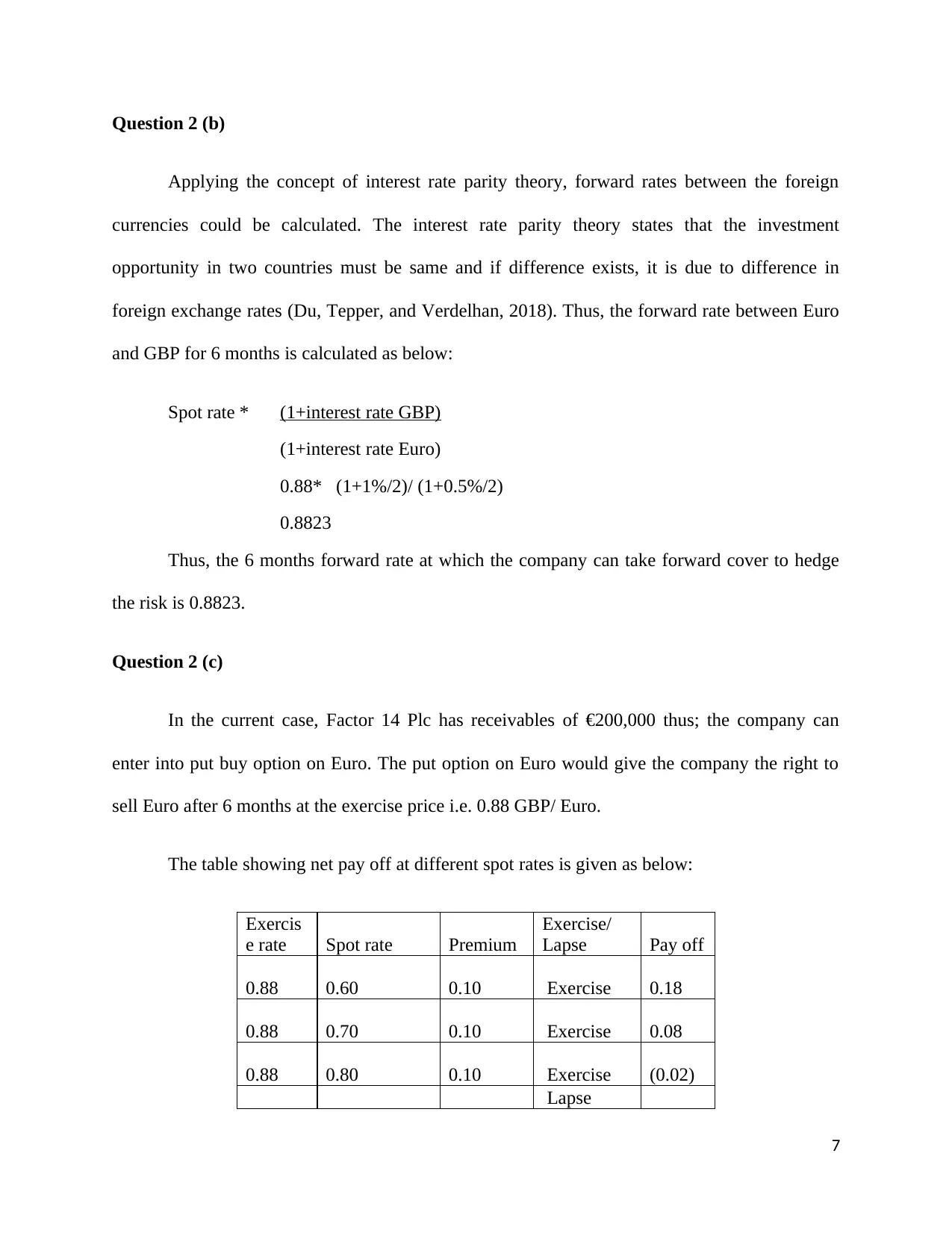
Question 2 (b)
Applying the concept of interest rate parity theory, forward rates between the foreign
currencies could be calculated. The interest rate parity theory states that the investment
opportunity in two countries must be same and if difference exists, it is due to difference in
foreign exchange rates (Du, Tepper, and Verdelhan, 2018). Thus, the forward rate between Euro
and GBP for 6 months is calculated as below:
Spot rate * (1+interest rate GBP)
(1+interest rate Euro)
0.88* (1+1%/2)/ (1+0.5%/2)
0.8823
Thus, the 6 months forward rate at which the company can take forward cover to hedge
the risk is 0.8823.
Question 2 (c)
In the current case, Factor 14 Plc has receivables of €200,000 thus; the company can
enter into put buy option on Euro. The put option on Euro would give the company the right to
sell Euro after 6 months at the exercise price i.e. 0.88 GBP/ Euro.
The table showing net pay off at different spot rates is given as below:
Exercis
e rate Spot rate Premium
Exercise/
Lapse Pay off
0.88 0.60 0.10 Exercise 0.18
0.88 0.70 0.10 Exercise 0.08
0.88 0.80 0.10 Exercise (0.02)
Lapse
7
Applying the concept of interest rate parity theory, forward rates between the foreign
currencies could be calculated. The interest rate parity theory states that the investment
opportunity in two countries must be same and if difference exists, it is due to difference in
foreign exchange rates (Du, Tepper, and Verdelhan, 2018). Thus, the forward rate between Euro
and GBP for 6 months is calculated as below:
Spot rate * (1+interest rate GBP)
(1+interest rate Euro)
0.88* (1+1%/2)/ (1+0.5%/2)
0.8823
Thus, the 6 months forward rate at which the company can take forward cover to hedge
the risk is 0.8823.
Question 2 (c)
In the current case, Factor 14 Plc has receivables of €200,000 thus; the company can
enter into put buy option on Euro. The put option on Euro would give the company the right to
sell Euro after 6 months at the exercise price i.e. 0.88 GBP/ Euro.
The table showing net pay off at different spot rates is given as below:
Exercis
e rate Spot rate Premium
Exercise/
Lapse Pay off
0.88 0.60 0.10 Exercise 0.18
0.88 0.70 0.10 Exercise 0.08
0.88 0.80 0.10 Exercise (0.02)
Lapse
7
Paraphrase This Document
Need a fresh take? Get an instant paraphrase of this document with our AI Paraphraser
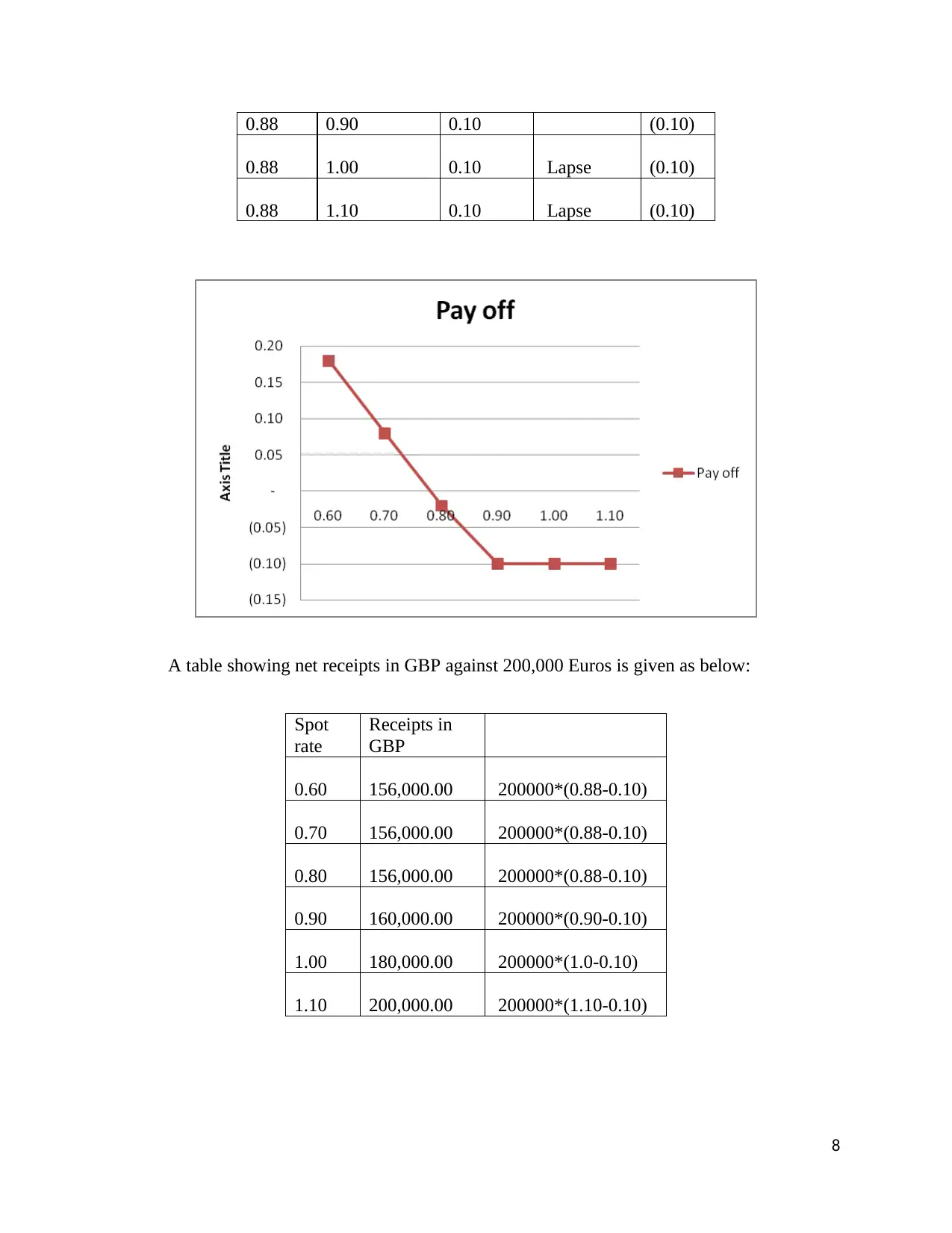
0.88 0.90 0.10 (0.10)
0.88 1.00 0.10 Lapse (0.10)
0.88 1.10 0.10 Lapse (0.10)
A table showing net receipts in GBP against 200,000 Euros is given as below:
Spot
rate
Receipts in
GBP
0.60 156,000.00 200000*(0.88-0.10)
0.70 156,000.00 200000*(0.88-0.10)
0.80 156,000.00 200000*(0.88-0.10)
0.90 160,000.00 200000*(0.90-0.10)
1.00 180,000.00 200000*(1.0-0.10)
1.10 200,000.00 200000*(1.10-0.10)
8
0.88 1.00 0.10 Lapse (0.10)
0.88 1.10 0.10 Lapse (0.10)
A table showing net receipts in GBP against 200,000 Euros is given as below:
Spot
rate
Receipts in
GBP
0.60 156,000.00 200000*(0.88-0.10)
0.70 156,000.00 200000*(0.88-0.10)
0.80 156,000.00 200000*(0.88-0.10)
0.90 160,000.00 200000*(0.90-0.10)
1.00 180,000.00 200000*(1.0-0.10)
1.10 200,000.00 200000*(1.10-0.10)
8
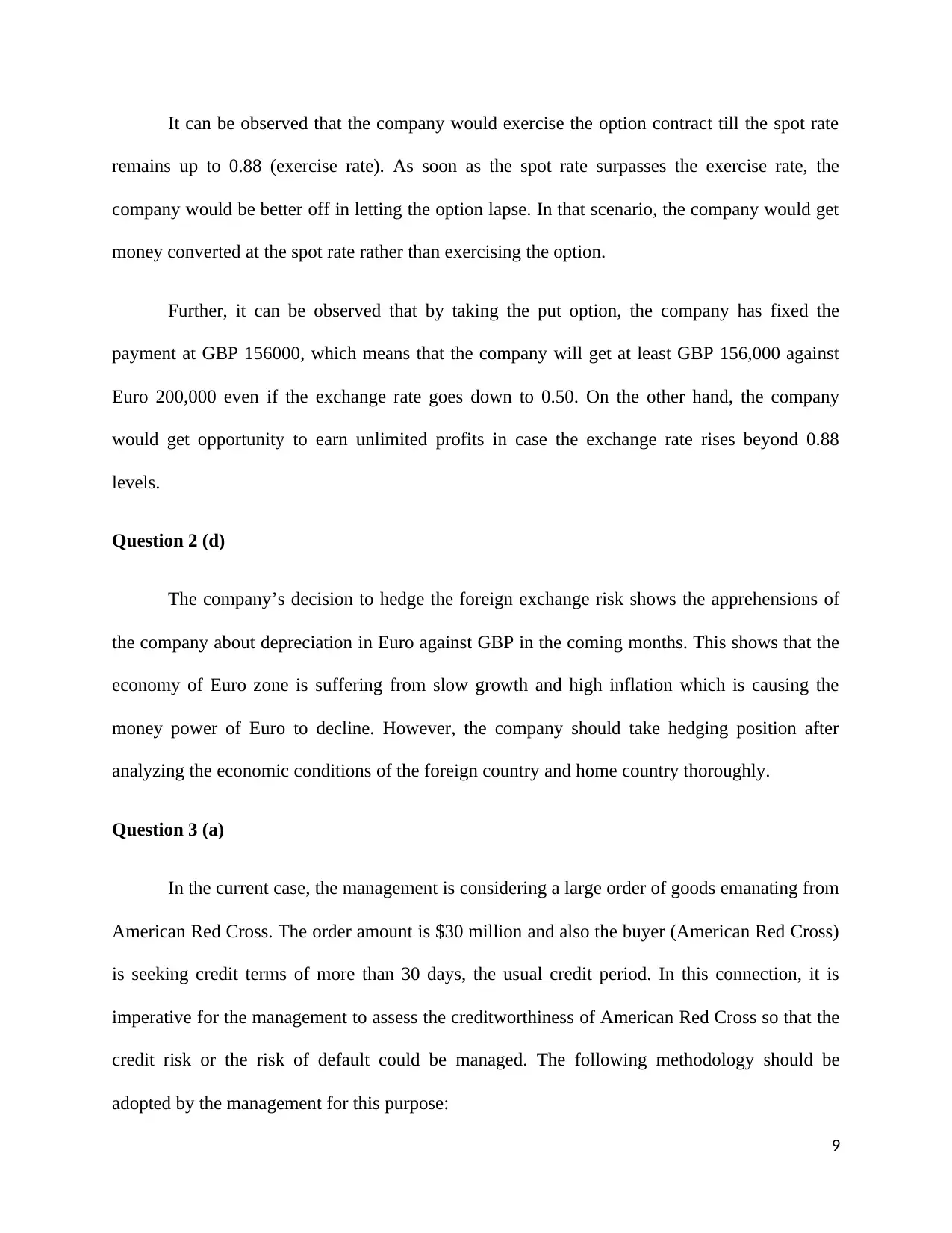
It can be observed that the company would exercise the option contract till the spot rate
remains up to 0.88 (exercise rate). As soon as the spot rate surpasses the exercise rate, the
company would be better off in letting the option lapse. In that scenario, the company would get
money converted at the spot rate rather than exercising the option.
Further, it can be observed that by taking the put option, the company has fixed the
payment at GBP 156000, which means that the company will get at least GBP 156,000 against
Euro 200,000 even if the exchange rate goes down to 0.50. On the other hand, the company
would get opportunity to earn unlimited profits in case the exchange rate rises beyond 0.88
levels.
Question 2 (d)
The company’s decision to hedge the foreign exchange risk shows the apprehensions of
the company about depreciation in Euro against GBP in the coming months. This shows that the
economy of Euro zone is suffering from slow growth and high inflation which is causing the
money power of Euro to decline. However, the company should take hedging position after
analyzing the economic conditions of the foreign country and home country thoroughly.
Question 3 (a)
In the current case, the management is considering a large order of goods emanating from
American Red Cross. The order amount is $30 million and also the buyer (American Red Cross)
is seeking credit terms of more than 30 days, the usual credit period. In this connection, it is
imperative for the management to assess the creditworthiness of American Red Cross so that the
credit risk or the risk of default could be managed. The following methodology should be
adopted by the management for this purpose:
9
remains up to 0.88 (exercise rate). As soon as the spot rate surpasses the exercise rate, the
company would be better off in letting the option lapse. In that scenario, the company would get
money converted at the spot rate rather than exercising the option.
Further, it can be observed that by taking the put option, the company has fixed the
payment at GBP 156000, which means that the company will get at least GBP 156,000 against
Euro 200,000 even if the exchange rate goes down to 0.50. On the other hand, the company
would get opportunity to earn unlimited profits in case the exchange rate rises beyond 0.88
levels.
Question 2 (d)
The company’s decision to hedge the foreign exchange risk shows the apprehensions of
the company about depreciation in Euro against GBP in the coming months. This shows that the
economy of Euro zone is suffering from slow growth and high inflation which is causing the
money power of Euro to decline. However, the company should take hedging position after
analyzing the economic conditions of the foreign country and home country thoroughly.
Question 3 (a)
In the current case, the management is considering a large order of goods emanating from
American Red Cross. The order amount is $30 million and also the buyer (American Red Cross)
is seeking credit terms of more than 30 days, the usual credit period. In this connection, it is
imperative for the management to assess the creditworthiness of American Red Cross so that the
credit risk or the risk of default could be managed. The following methodology should be
adopted by the management for this purpose:
9
⊘ This is a preview!⊘
Do you want full access?
Subscribe today to unlock all pages.

Trusted by 1+ million students worldwide
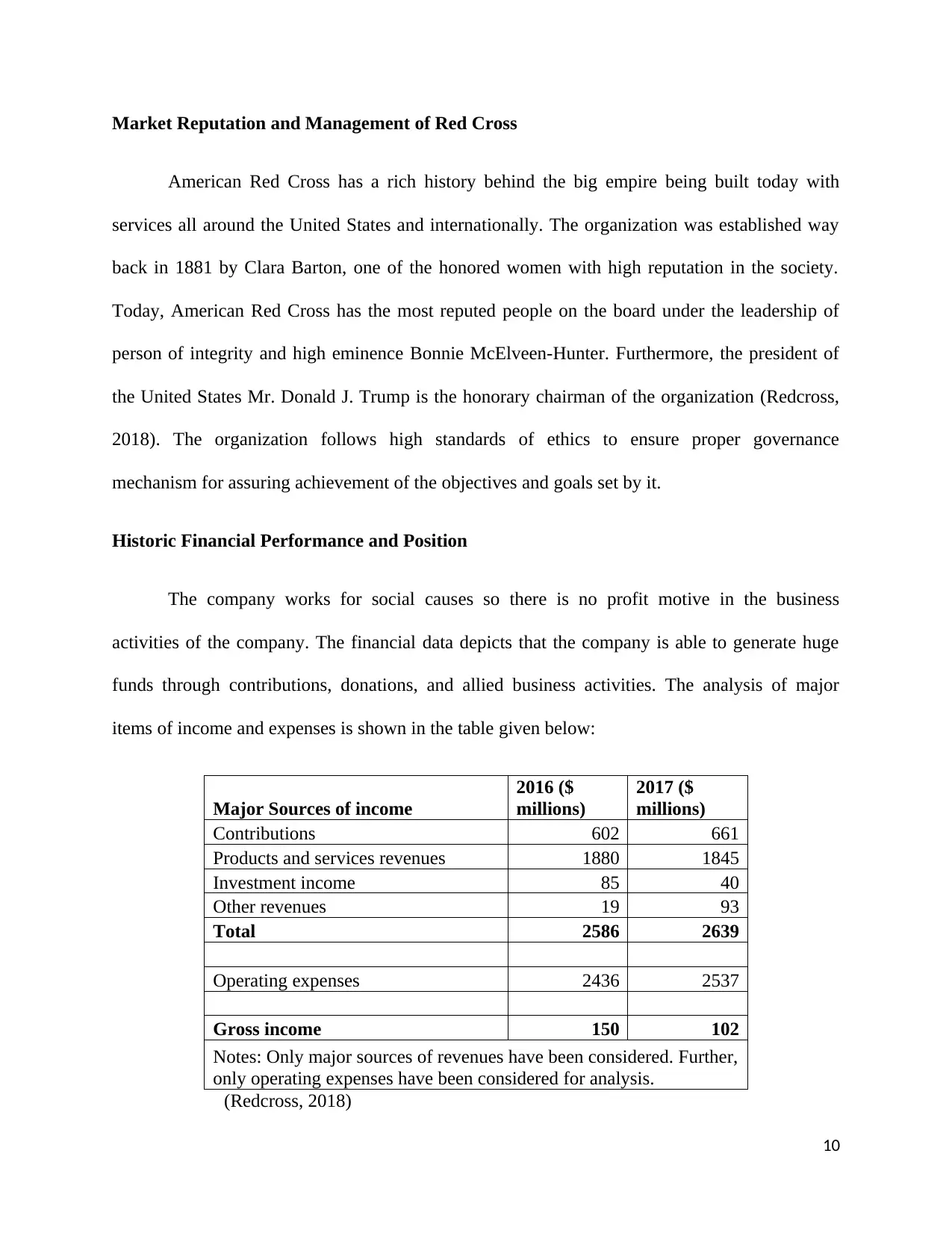
Market Reputation and Management of Red Cross
American Red Cross has a rich history behind the big empire being built today with
services all around the United States and internationally. The organization was established way
back in 1881 by Clara Barton, one of the honored women with high reputation in the society.
Today, American Red Cross has the most reputed people on the board under the leadership of
person of integrity and high eminence Bonnie McElveen-Hunter. Furthermore, the president of
the United States Mr. Donald J. Trump is the honorary chairman of the organization (Redcross,
2018). The organization follows high standards of ethics to ensure proper governance
mechanism for assuring achievement of the objectives and goals set by it.
Historic Financial Performance and Position
The company works for social causes so there is no profit motive in the business
activities of the company. The financial data depicts that the company is able to generate huge
funds through contributions, donations, and allied business activities. The analysis of major
items of income and expenses is shown in the table given below:
Major Sources of income
2016 ($
millions)
2017 ($
millions)
Contributions 602 661
Products and services revenues 1880 1845
Investment income 85 40
Other revenues 19 93
Total 2586 2639
Operating expenses 2436 2537
Gross income 150 102
Notes: Only major sources of revenues have been considered. Further,
only operating expenses have been considered for analysis.
(Redcross, 2018)
10
American Red Cross has a rich history behind the big empire being built today with
services all around the United States and internationally. The organization was established way
back in 1881 by Clara Barton, one of the honored women with high reputation in the society.
Today, American Red Cross has the most reputed people on the board under the leadership of
person of integrity and high eminence Bonnie McElveen-Hunter. Furthermore, the president of
the United States Mr. Donald J. Trump is the honorary chairman of the organization (Redcross,
2018). The organization follows high standards of ethics to ensure proper governance
mechanism for assuring achievement of the objectives and goals set by it.
Historic Financial Performance and Position
The company works for social causes so there is no profit motive in the business
activities of the company. The financial data depicts that the company is able to generate huge
funds through contributions, donations, and allied business activities. The analysis of major
items of income and expenses is shown in the table given below:
Major Sources of income
2016 ($
millions)
2017 ($
millions)
Contributions 602 661
Products and services revenues 1880 1845
Investment income 85 40
Other revenues 19 93
Total 2586 2639
Operating expenses 2436 2537
Gross income 150 102
Notes: Only major sources of revenues have been considered. Further,
only operating expenses have been considered for analysis.
(Redcross, 2018)
10
Paraphrase This Document
Need a fresh take? Get an instant paraphrase of this document with our AI Paraphraser
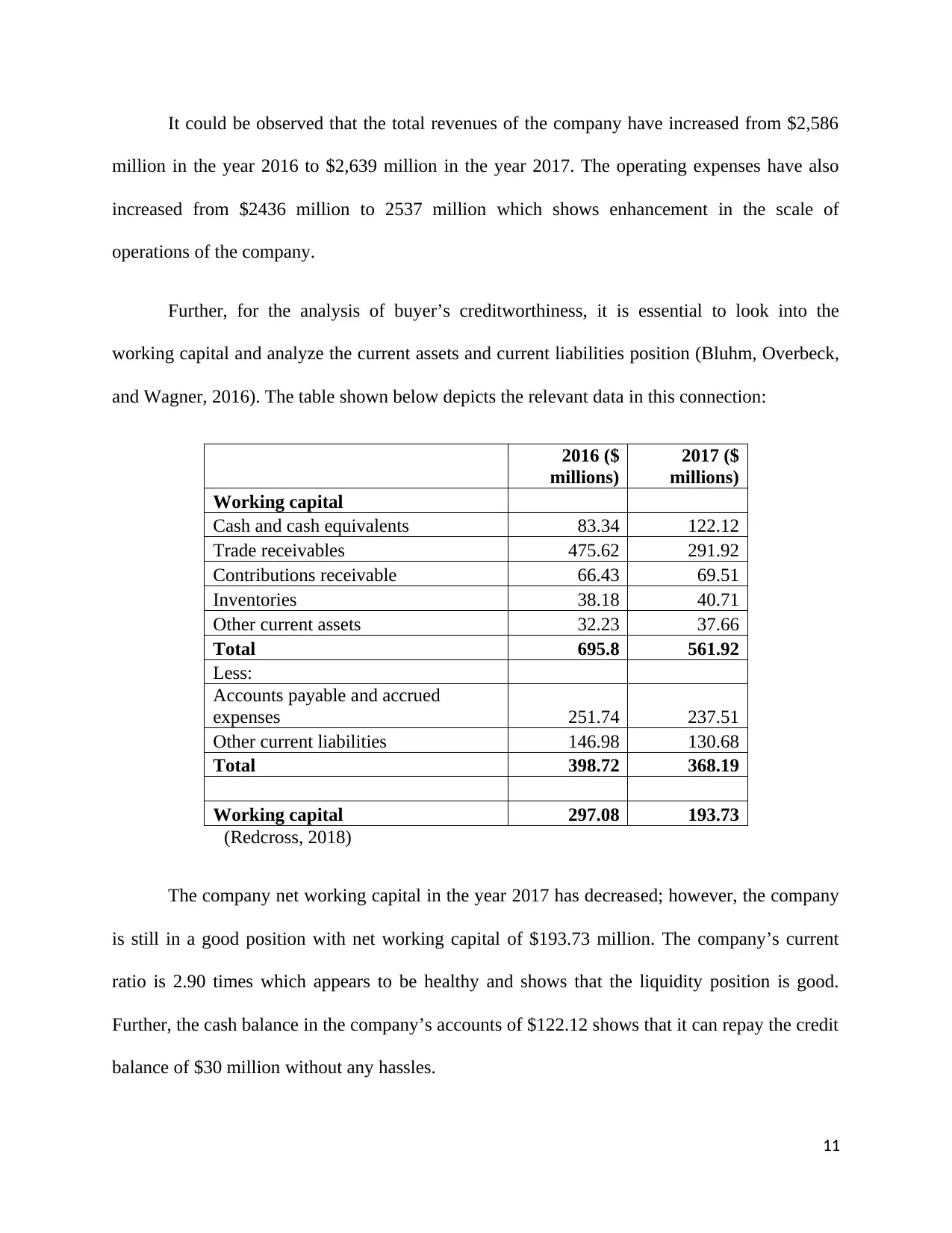
It could be observed that the total revenues of the company have increased from $2,586
million in the year 2016 to $2,639 million in the year 2017. The operating expenses have also
increased from $2436 million to 2537 million which shows enhancement in the scale of
operations of the company.
Further, for the analysis of buyer’s creditworthiness, it is essential to look into the
working capital and analyze the current assets and current liabilities position (Bluhm, Overbeck,
and Wagner, 2016). The table shown below depicts the relevant data in this connection:
2016 ($
millions)
2017 ($
millions)
Working capital
Cash and cash equivalents 83.34 122.12
Trade receivables 475.62 291.92
Contributions receivable 66.43 69.51
Inventories 38.18 40.71
Other current assets 32.23 37.66
Total 695.8 561.92
Less:
Accounts payable and accrued
expenses 251.74 237.51
Other current liabilities 146.98 130.68
Total 398.72 368.19
Working capital 297.08 193.73
(Redcross, 2018)
The company net working capital in the year 2017 has decreased; however, the company
is still in a good position with net working capital of $193.73 million. The company’s current
ratio is 2.90 times which appears to be healthy and shows that the liquidity position is good.
Further, the cash balance in the company’s accounts of $122.12 shows that it can repay the credit
balance of $30 million without any hassles.
11
million in the year 2016 to $2,639 million in the year 2017. The operating expenses have also
increased from $2436 million to 2537 million which shows enhancement in the scale of
operations of the company.
Further, for the analysis of buyer’s creditworthiness, it is essential to look into the
working capital and analyze the current assets and current liabilities position (Bluhm, Overbeck,
and Wagner, 2016). The table shown below depicts the relevant data in this connection:
2016 ($
millions)
2017 ($
millions)
Working capital
Cash and cash equivalents 83.34 122.12
Trade receivables 475.62 291.92
Contributions receivable 66.43 69.51
Inventories 38.18 40.71
Other current assets 32.23 37.66
Total 695.8 561.92
Less:
Accounts payable and accrued
expenses 251.74 237.51
Other current liabilities 146.98 130.68
Total 398.72 368.19
Working capital 297.08 193.73
(Redcross, 2018)
The company net working capital in the year 2017 has decreased; however, the company
is still in a good position with net working capital of $193.73 million. The company’s current
ratio is 2.90 times which appears to be healthy and shows that the liquidity position is good.
Further, the cash balance in the company’s accounts of $122.12 shows that it can repay the credit
balance of $30 million without any hassles.
11
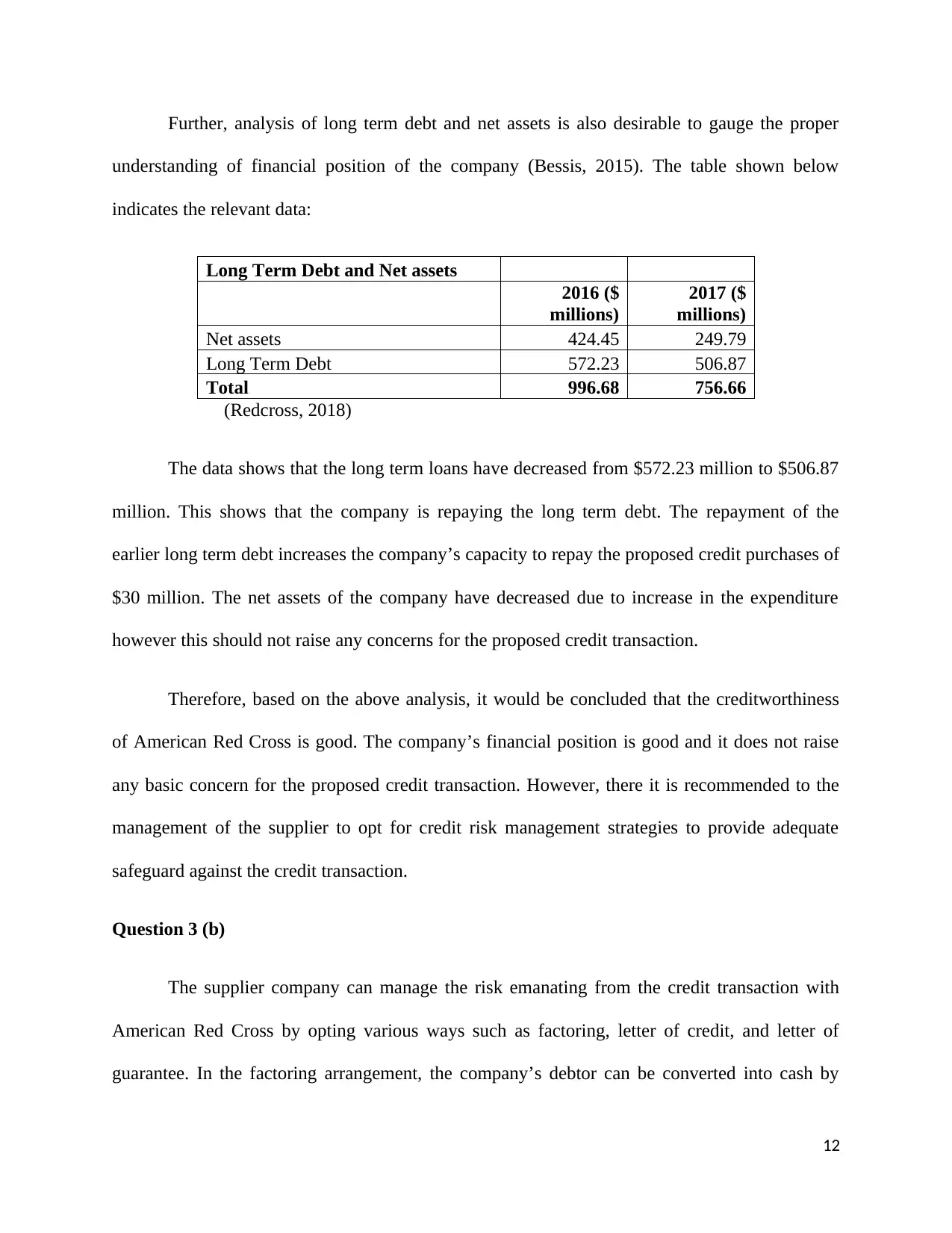
Further, analysis of long term debt and net assets is also desirable to gauge the proper
understanding of financial position of the company (Bessis, 2015). The table shown below
indicates the relevant data:
Long Term Debt and Net assets
2016 ($
millions)
2017 ($
millions)
Net assets 424.45 249.79
Long Term Debt 572.23 506.87
Total 996.68 756.66
(Redcross, 2018)
The data shows that the long term loans have decreased from $572.23 million to $506.87
million. This shows that the company is repaying the long term debt. The repayment of the
earlier long term debt increases the company’s capacity to repay the proposed credit purchases of
$30 million. The net assets of the company have decreased due to increase in the expenditure
however this should not raise any concerns for the proposed credit transaction.
Therefore, based on the above analysis, it would be concluded that the creditworthiness
of American Red Cross is good. The company’s financial position is good and it does not raise
any basic concern for the proposed credit transaction. However, there it is recommended to the
management of the supplier to opt for credit risk management strategies to provide adequate
safeguard against the credit transaction.
Question 3 (b)
The supplier company can manage the risk emanating from the credit transaction with
American Red Cross by opting various ways such as factoring, letter of credit, and letter of
guarantee. In the factoring arrangement, the company’s debtor can be converted into cash by
12
understanding of financial position of the company (Bessis, 2015). The table shown below
indicates the relevant data:
Long Term Debt and Net assets
2016 ($
millions)
2017 ($
millions)
Net assets 424.45 249.79
Long Term Debt 572.23 506.87
Total 996.68 756.66
(Redcross, 2018)
The data shows that the long term loans have decreased from $572.23 million to $506.87
million. This shows that the company is repaying the long term debt. The repayment of the
earlier long term debt increases the company’s capacity to repay the proposed credit purchases of
$30 million. The net assets of the company have decreased due to increase in the expenditure
however this should not raise any concerns for the proposed credit transaction.
Therefore, based on the above analysis, it would be concluded that the creditworthiness
of American Red Cross is good. The company’s financial position is good and it does not raise
any basic concern for the proposed credit transaction. However, there it is recommended to the
management of the supplier to opt for credit risk management strategies to provide adequate
safeguard against the credit transaction.
Question 3 (b)
The supplier company can manage the risk emanating from the credit transaction with
American Red Cross by opting various ways such as factoring, letter of credit, and letter of
guarantee. In the factoring arrangement, the company’s debtor can be converted into cash by
12
⊘ This is a preview!⊘
Do you want full access?
Subscribe today to unlock all pages.

Trusted by 1+ million students worldwide
1 out of 19
Your All-in-One AI-Powered Toolkit for Academic Success.
+13062052269
info@desklib.com
Available 24*7 on WhatsApp / Email
![[object Object]](/_next/static/media/star-bottom.7253800d.svg)
Unlock your academic potential
Copyright © 2020–2025 A2Z Services. All Rights Reserved. Developed and managed by ZUCOL.


